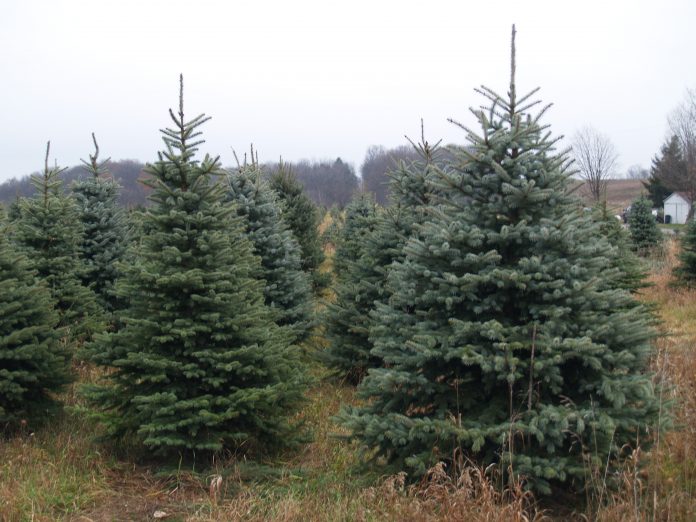By Sherrie R. Whaley
Ohio State University College of Food, Agricultural and Environmental Sciences
Let’s assume that you and your significant other have already hashed out the real vs. fake Christmas tree debate. If the real tree won, raise a glass of eggnog to that!
Nothing says happy holidays quite like the amazing scent of a live tree in your house. And, if you cut down your tree on an Ohio Christmas tree farm, you’re helping to support local farmers, many of whom have been growing trees on family farms for generations.
It’s probably no shock, but choosing and cutting your own Christmas tree guarantees the freshest tree possible and can be a great family holiday tradition when you hike out in the fields to pick your perfect tree. Christmas trees are even a sustainable resource since they clean the air, and the tree farms are usually on land that’s unsuitable for other crops.
But what’s the best type of Christmas tree to look for? “There’s no one best species when it comes to choosing a Christmas tree,” said Kathy Smith, Extension forestry program director at The Ohio State University’s College of Food, Agricultural, and Environmental Sciences. “It all comes down to what you like and what’s available locally.”
The Ohio Christmas Tree Association lists 14 different species grown in Ohio and tells about the characteristics of each here. If you’re looking for the nearest tree farm to start your holiday tradition, or you just need to know the hours and prices at your favorite farm, check out the Ohio Christmas Tree Association’s Farm Finder page.
If you prefer the convenience of pre-cut live trees, many of which are sold at retail lots, look for certain features when buying, Smith said. “Most commercially available Christmas trees on lots are harvested the first couple weeks of November, which means that they may not last as long as a fresh cut tree.”
A few tips from Smith:
- For starters, grab a handful of needles and pull: Most needles should stay firmly attached and feel pliable. All evergreens shed their oldest needles every year, so don’t worry about the brown needles that fall down from the inside of the tree if you tap the base on the ground. Lastly, look for a tree with a fresh scent and bright green appearance, and a stump that’s sticky with fresh sap.
- A fresh tree will lose few, if any, green needles. Two other options are to …
- Hold the tree by its trunk and shake it. Or bounce the bottom of the trunk on the ground. Again, a fresh tree should lose few, if any, green needles.
- Keep the tree in a cool, protected place if you don’t plan to take it indoors right away. Put it under an overhang, say, or in an unheated garage or porch.
- If you’re going to store the tree outside for a couple of days, put the end of its trunk in a bucket of water. But first …
- If the tree has been cut for more than 6-8 hours — and so has been out of water that long — make a new, straight cut at the bottom of the trunk. Use a saw to cut an inch or so off the end. Otherwise, during that time, sap will have started to seal the original cut. The tree won’t take up water as well, or maybe not at all, and will dry out sooner than it should.
- Keep the room cooler than normal, if possible, once you set up the tree. If you can, turn down the thermostat, or close or partly close the room’s heat vents. This slows down the tree’s drying out.
- For the same reason, locate the tree away from heat vents, fireplaces, radiators, and windows that get direct sunlight.
- Last, but not least, the real secret to Christmas tree success is WATER. Your tree will drink a lot—and we do mean a lot—of water, especially in the first week. Ideally, use a tree stand that can hold at least 1 gallon of water, and more for bigger trees. Keep it filled. Check it daily. Don’t get lazy and don’t let the water get lower than the end of the trunk. If the water gets too low, the end will seal with sap resulting in little or no uptake of water and premature drying out.
Also, don’t drill a hole in the trunk to improve water uptake (this doesn’t work!) or whittle off the outer layers to fit it in your stand (those layers are most efficient at taking up water, so you’re actually harming the tree).
You’ve probably been told to add things like soda, aspirin, bleach, molasses, sugar, honey, commercial tree preservative, or whatever else to your tree stand to make the tree last longer. No matter what you’ve seen on social media, the science just doesn’t support it. In fact, research has shown that some substances actually harm the tree and cause needle drop! Trees only drink water in the wild and that’s all they need indoors, too.
According to Smith, most fresh-cut trees will last a month with proper care. Remember when it’s time to take down the Christmas tree, it still has a useful life left! Cut boughs and cover perennials to shield them from cold and wind, or place them on the ground near your bird feeders to create protection for ground-feeding birds. Also, check with your community for free pick-up or drop-off services that grind Christmas trees into garden mulch.










